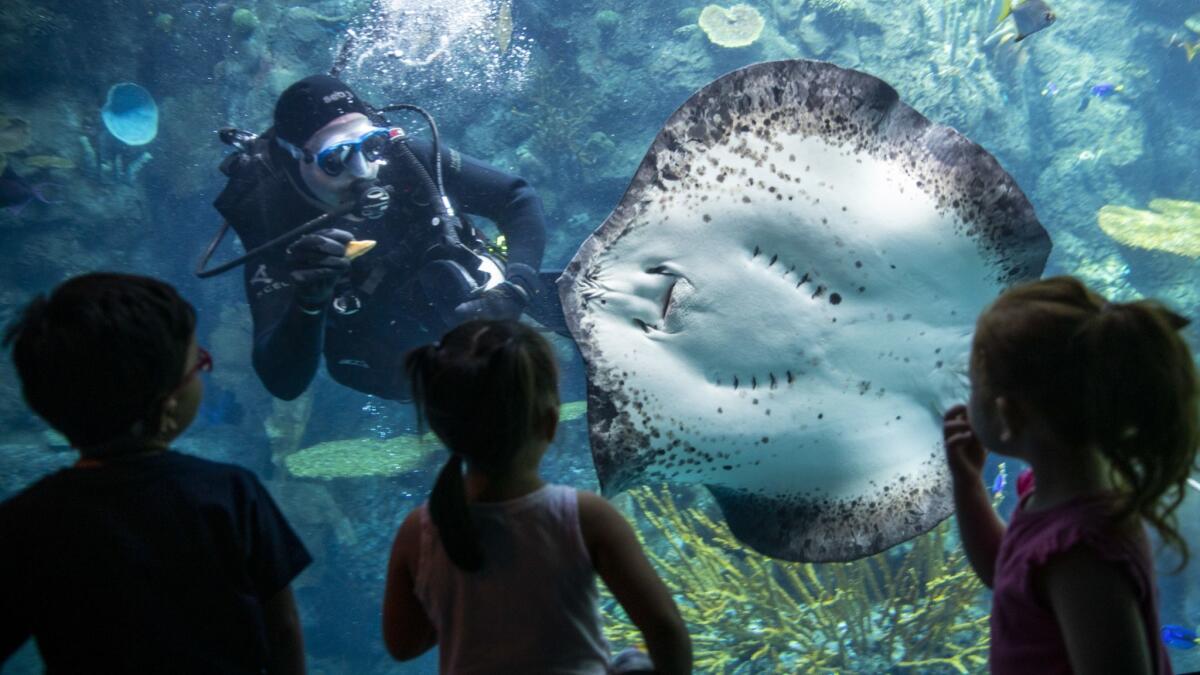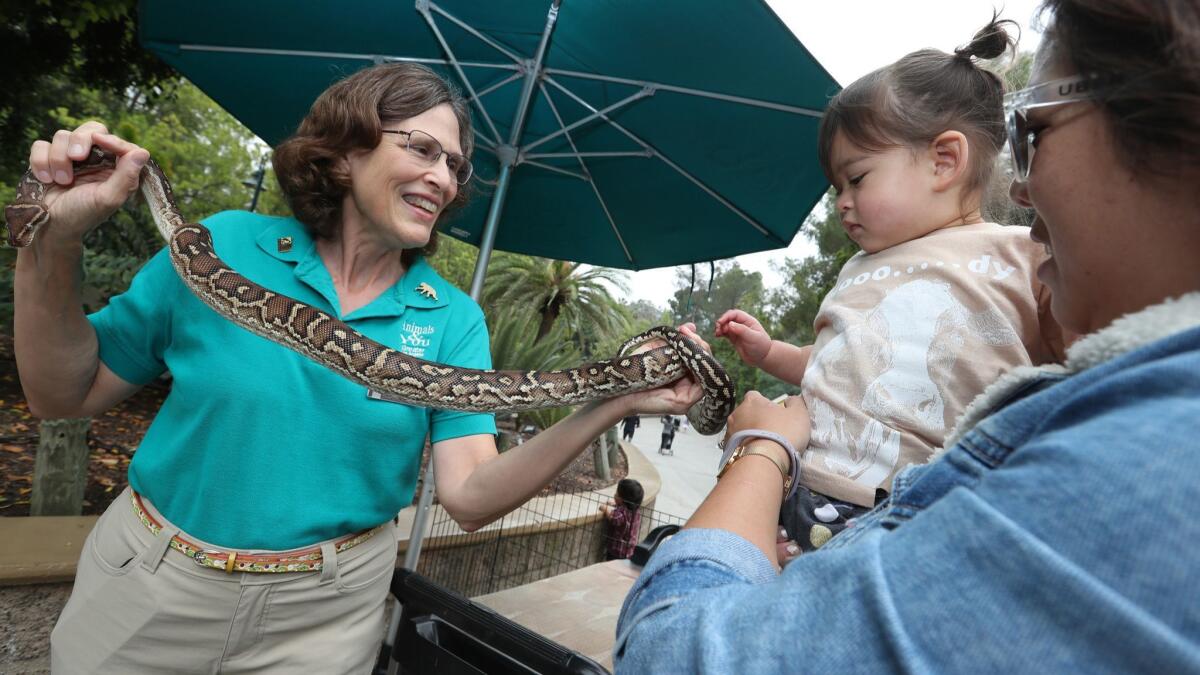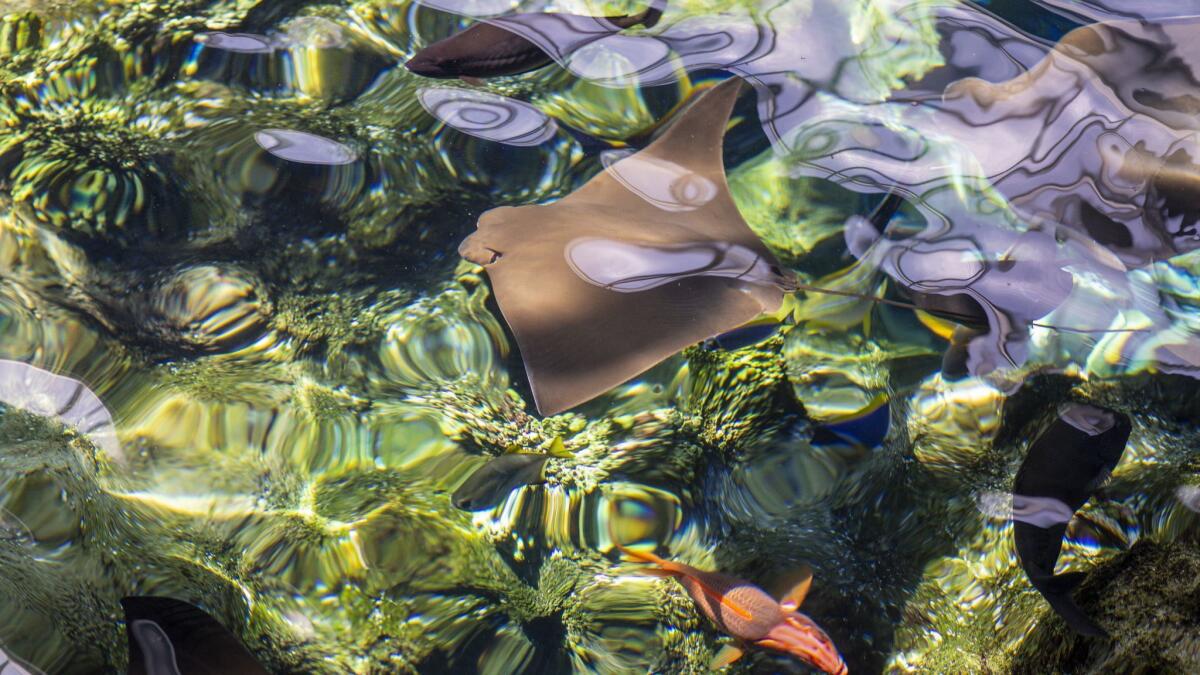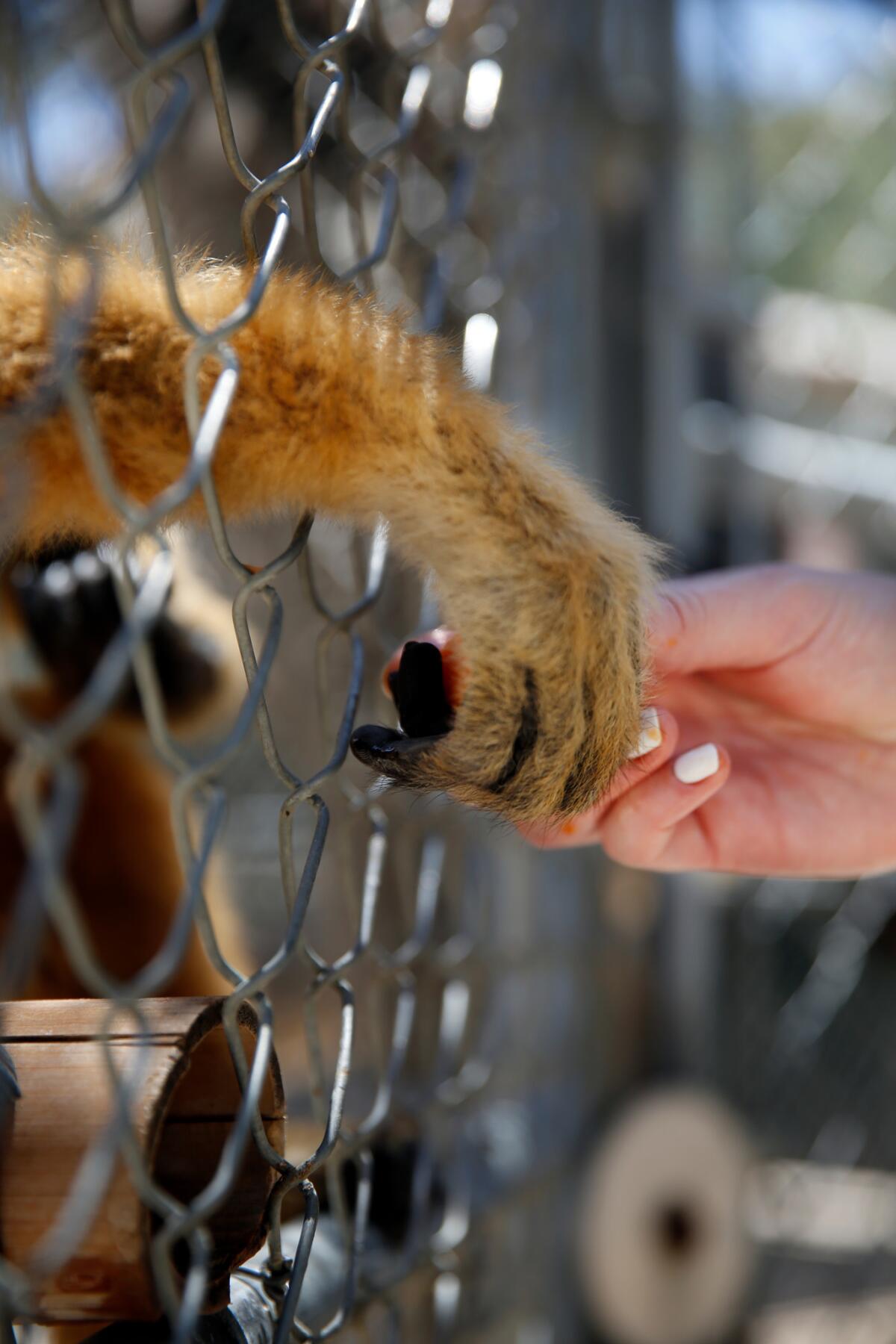Want to get close to gibbons or pythons? Volunteer at one of these L.A. places

Sophia Paden holds a piece of papaya up to the fence for Pepper, a northern white-cheeked gibbon, whose counterparts in the wild number fewer than 1,000. The gibbon reaches out and takes it. Paden, 25, who studies exotic animal training at a community college, had to log 100 volunteer hours at the Gibbon Conservation Center in Santa Clarita before she could learn to feed the 38 gibbons that live here.

For the record:
5:30 p.m. July 4, 2019A previous version of this story incorrectly said how many gibbons are cared for at the Gibbon Conservation Center. There are 38.
She has prepared the animals’ food, answered visitors’ questions and even staffed the gift shop at the center. “The moment of closeness between human and wild animal is magical,” Paden said. “It makes me feel that this is what I was meant to do.”
Paden is one of Southern California’s hundreds of dedicated volunteers who commit their free time to helping some of the world’s most exotic species.
They’ll do whatever it takes to get close to creatures they would have little chance of meeting so intimately in the wild, animals in danger of extinction because of climate change, pollution and habitat destruction.
If you are willing to commit your time, here are five places where you can be trained to make that animal connection and do your bit for wildlife conservation.
Los Angeles Zoo & Botanical Gardens
“The L.A. Zoo’s my happy place,” says Paula Riggin, one of the roughly 300 active volunteer docents. “I can be in the worst mood after fighting traffic, but it disappears the minute I get here.” On a recent day, her assignment was to show visitors an Angolan python at one of the zoo’s Animal & You kiosks. A little girl eyed the snake warily.
“Do you think Audrey is soft or scratchy?” Riggin asked her. The child hesitantly touched the snake, then broke into a smile. “Soft!”
The main job of zoo volunteer docents is to lead educational tours for thousands of schoolchildren who visit the zoo on field trips. “It’s a thrill to watch kids’ faces light up at seeing a giraffe or an elephant for the first time,” Riggin said. “And if I can teach them even a little bit about saving endangered animals, it makes my day.”

A retired bank-operations manager, Riggin enrolled in the docent training program in 2016. The 23-week course includes weekly zoology lectures and behind-the-scenes visits to the animal exhibits. “I learned so much and bonded with my classmates,” she said. “It was life-changing.”
Riggin will be one of the co-chairs of the next L.A. Zoo docent training program, which begins in October. At 10:30 a.m. July 20, potential applicants can enter the zoo for free to attend an informational meeting. “Current docents will give zoo tours after the meeting,” Riggin said. “We’re eager to share our passion for wildlife [and] conservation and the fun of being an L.A. Zoo docent.” (Full disclosure: The author is a docent at the zoo.)
Info: Los Angeles Zoo & Botanical Gardens, 5333 Zoo Drive, (look for volunteer docent information and applications on the website).
Professional technical writer Betsy Suttle has been a volunteer at the Aquarium of the Pacific in Long Beach for the last 20 years.

As one of 130 volunteer divers, Suttle dons scuba gear, grabs a bucket of thawed frozen fish and jumps into the 350,000-gallon Tropical Reef exhibit. She hand-feeds bluefin trevallies, sailfin tangs and other fish as visitors look on. “Diving in the exhibit is more fun than diving in the ocean,” she says. “There the fish swim away from you. Here they swarm all over you!”
Suttle was required to have Rescue Diver scuba certification and commit to a weekly four- to five-hour shift for at least a year to qualify for her position. Volunteer opportunities that require less training and time commitments range from assisting staff with animal care and aquarium maintenance, to engaging with visitors at interactive wet stations where they can touch stingrays, sharks and other aquatic animals.
“Every one of our 1,200 volunteers starts their training here with 16 hours of marine biology education,” volunteer director Sean Devereaux said. “We call it ‘Aquarium 101.’”
Info: Aquarium of the Pacific, 100 Aquarium Way, Long Beach; aquariumofpacific.org

The Gibbon Conservation Center in Santa Clarita houses the rarest group of small Asian apes in the Western Hemisphere. “Our goal is to preserve their species and educate people about them,” says director Gabi Skollar, an expert on gibbon behavior and conservation. “We have around 10 volunteers who are experienced enough to feed the gibbons, like Sophia,” she said. “But not everyone can make the time commitment that requires.”
People interested in volunteering to lead tours at the center are welcome to attend the tours Skollar gives on Saturday and Sunday mornings, the only days the center is open to the public. “Or they can attend one of the Yoga With Gibbons sessions we hold the first Saturday morning of the month,” she said.
Info: Gibbon Conservation Center, 19100 Esguerra Road, Santa Clarita
Ruby Kumagai wears rubber waders, boots and gloves to hose down a pen at the Marine Mammal Care Center in San Pedro. Each year the nonprofit cares for more than 300 sick, injured and stranded seals and sea lions recovered from Los Angeles County beaches. “The first time I came here I couldn’t believe all the barking, and the smell of fish was insane,” she said. “But then this cute ‘ellie’ — an elephant seal pup — made eye contact with me, like it wanted my help. I had to stay.”

A part-time employee at L.A. Recreation and Parks, Kumagai has been an animal-care volunteer here since 2013. She works three four-hour shifts a week. In addition to cleaning sea-mammal enclosures, her tasks include doing laundry; thawing, sorting and tossing fish to adult animals; and tube-feeding nutritious fish smoothies to pups. “The pups come in here so sickly and skinny, but after a few weeks they learn to eat fish on their own and they fatten up,” she said. “I feel so happy when they’re healthy enough to be released back into the ocean.”
The center welcomes volunteer applications year-round but has the greatest need for volunteers in spring and summer, when more stranded seal and sea lion pups wind up being rescued. Orientations are held for new volunteers as needed.
Executive director Jeff Cozad acknowledges that some of their volunteers don’t like handling fish and getting wet. “We’re fine with that,” he says. “Volunteers are vital to our success, including those who work in the gift shop and talk to visitors, explaining what we do to save sea mammals.”
Info: Marine Mammal Care Center, 3601 S. Gaffey St., San Pedro
International Bird Rescue Center
At the International Bird Rescue Center opposite the Marine Mammal Care Center, volunteer Mary Lawrence Test carries an injured pelican wrapped in a sheet to an examining table. She makes sure that its head is covered as she helps staff technician Miranda Starr examine its wings, beak and feet. “Birds are easily stressed when they see humans,” Test said. “We want to keep them calm.”

Test, a lawyer/mediator, has volunteered at the clinic since 2011. “It’s not easy work but it’s very rewarding,” she said. “You have to thaw fish and clean the aviaries, and you can be holding a bird that poops on you, but I love doing it because I love birds.”
The bird rescue center has around 60 volunteers a year. “When there is an oil spill, we rely heavily on their help,” said manager Kylie Clatterbuck. “Currently we have more than 100 birds in our care, including orphaned herons, egrets and ducklings, on top of gulls and pelicans recovering from injuries. Our job is to give them the time and care they need to heal and then release them back into the wild.”
Info: International Bird Rescue Center, 3601 S. Gaffey St., San Pedro
More to Read
Sign up for our L.A. Times Plants newsletter
At the start of each month, get a roundup of upcoming plant-related activities and events in Southern California, along with links to tips and articles you may have missed.
You may occasionally receive promotional content from the Los Angeles Times.






